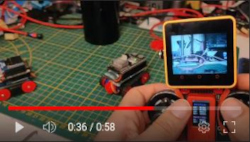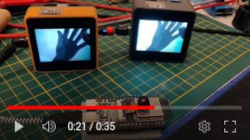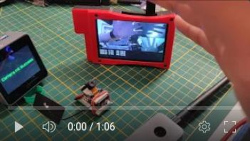The ESPNowCam library is a simple and direct video or data streamer designed for popular ESP32 devices, utilizing the ESPNow protocol. No need for IPs, routers, or credentials—keeping it straightforward and hassle-free! :D
Tip
This library is for general purpose, as it accepts pointers to various types of data, including buffers, strings, images, or any byte-formatted content. This flexibility enables transmission of larger packages across different scenarios, not limited to cameras alone. For instance, a buffer of 4000 bytes takes approximately 1/9 of a second to transmit, resulting in a frame rate of around 9FPS.
| Don't forget to star ⭐ this repository |
The latest version brings numerous enhancements and is currently highly stable. It offers support for various transmission modes including:
- One transmitter to multiple receivers using the internal ESPNow broadcasting feature (1:N mode).
- Peer-to-peer (P2P) connections utilizing MAC address targeting (1:1 mode).
- Multi-sender mode with one receiver (N:1 mode).
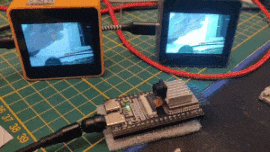
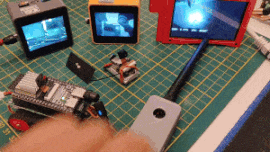
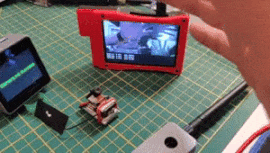
[1:N mode video] [1:1 mode video] [N:1 mode video]
Tip
It's important to note that the library is versatile and capable of transmitting various types of data, not limited to video.
The current version was tested with the next cameras:
| Sender | Frame | PSRAM | JPGQ | FPS | Status |
|---|---|---|---|---|---|
| TTGO TJournal | QVGA | No | 12 | ~11 FPS | STABLE |
| XIAO Sense S3 | QVGA | Yes | 12 | ~11 FPS | STABLE |
| Freenove S3 | QVGA | Yes | 12 | ~10 FPS | STABLE |
| Freenove S3 | HVGA | Yes | 12 | ~6 FPS | STABLE |
| M5CoreS3 | QVGA | Yes | 12 | ~11 FPS | STABLE |
| M5UnitCamS3 | QVGA | Yes | 12 | ~9 FPS | STABLE |
Full list of senders and receivers that was tested
PlatformIO:
Add the following line to the lib_deps option of your [env:] section:
hpsaturn/EspNowCam@^0.1.13Or via command line:
pio pkg install --library "hpsaturn/ESPNowCam@^0.1.13"Arduino IDE:
Important
For Arduino IDE is a little bit more complicated because the Arduino IDE dependencies resolver is very bad, but you only need:
- Download and install the Nanopb library using the
Include Librarysection via zip file - and then with the Library Manager find ESPNowCam and install it.
Tip
Nanobp is not included as a dependency because, despite being 25 years after the invention of symbolic links, Arduino IDE does not support these types of files. Consider exploring PlatformIO for your future developments, as it offers a more versatile and modern development environment.
To send any kind of data, you only need a buffer and the size to send:
ESPNowCam radio;
radio.init();
radio.sendData(out_jpg, out_jpg_len);To receive the data, you only need to define a buffer and callback:
radio.setRecvBuffer(fb);
radio.setRecvCallback(onDataReady);
radio.init();void onDataReady(uint32_t lenght) {
tft.drawJpg(fb, lenght , 0, 0, dw, dh);
}Note
If you don't define any specific target, the radio will work in broadcasting mode, that means 1:N mode, for instance one camera sending video to multiple screen receivers.
It's also possible to define a specific target:
const uint8_t macRecv[6] = {0xB8,0xF0,0x09,0xC6,0x0E,0xCC};
radio.setTarget(macRecv);
radio.init();Tip
This mode is very recommended to increase the performance, and also it reduces the noise and possible glitches.
Is possible too configure multiple cameras or senders to only one receiver, N:1 mode, configuring filters by MAC in the receiver:
radio.setRecvFilter(fb_cam1, mac_cam1, onCam1DataReady);
radio.setRecvFilter(fb_cam2, mac_cam2, onCam2DataReady);
radio.setRecvFilter(fb_cam3, mac_cam3, onCam3DataReady);and each camera should have configured the receiver MAC like a target. Fore more details, please follow the multi-camera-one-receiver directory example.
The library includes some pre-defined camera configs to have an easy implementation, for example:
#include <ESPNowCam.h>
#include <drivers/CamFreenove.h>
CamFreenove Camera;Tip
For now, it includes drivers for FreenoveS3, XIAOS3, M5UnitCamS3, Freenove WRover, ESP32Cam AI-Thinker and the TTGO T-Journal cameras, but you are able to define your custom camera like is shown in the custom-camera-sender example. If you can run it in a different camera, please notify me via a GitHub issue or please contribute with the project sending a pull request :D
Well, in my last tests with different cameras and using QVGA frame size, seems that is better using the DRAM and the internal JPG. DRAM is more faster than PSRAM, and the internal compressor has a better quality with the same JPGQ level, but it uses more bandwidth, on the other hand the result is so good on P2P mode.
For change to DRAM and the internal JPG, you are able to pre-configure it like this:
Camera.config.pixel_format = PIXFORMAT_JPEG;
Camera.config.frame_size = FRAMESIZE_QVGA;
Camera.config.fb_count = 2;
Camera.config.fb_location = CAMERA_FB_IN_DRAM;more details in the sample xiao-internal-jpg-sender.
For install and run the examples, first install PlatformIO open source ecosystem for IoT development compatible with Arduino IDE and its command line tools (Windows, MacOs and Linux). Also, you may need to install git in your system.
Then compile and install each sample, only choose one of them ENV names in the table, and run the next command in the root of this project, like this:
pio run -e m5cores3-espnow-receiver --target uploadSome examples are for Arduino users (*.ino samples), but is possible too compile and install it from PlatformIO, only needs run the next command into each directory:
pio run --target uploadNote
To increase the performance, the recommended use is the 1:1 mode, and also is a good practice to configure the other radio senders around of this device in this mode, because if you have other senders in broadcasting mode together, them could be generating interference.
The Freenove camera sometimes needs good power cable and also takes some seconds to stabilization, that means, that not worries for initial video glitches.
pb_decode.h error: For Arduino IDE users, if you have a compiler error, maybe you forget install NanoPb library. Please see above in library installation section.
Tip
This project was developed and thoroughly tested on PlatformIO. While I did compile and execute it successfully on Arduino IDE using Espressif 2.0.11 and Arduino IDE 2.2.1, with PSRAM enabled, I generally avoid using Arduino IDE due to its tendency to mix everything and its buggy nature. Therefore, I highly recommend using PlatformIO for a smoother and more reliable development experience.
- NanoPb possible issue #1 (payload size)
- Unified ESPNow in an one class for all transmitters and receivers
- Isolate the ESPNow Receiver and Transmitter in a seperated library
- Add sender callback to improve speed
- Added internal drivers for some popular Cameras
- Added multi-camera support with one only target
- Migration to esp_wifi_80211_tx() to improve Payload and Quality
I want to extend my gratitude to:
@ElectroZeusTIC and @AcoranTf for testing on Arduino IDE.
@UtaAoya for findings related to the M5UnitCam device.
@MeloCuentan for fixing issues with the AI-Thinker Camera and the new ESP32S3 RGB receiver.
@turmandreams for tests on the AI-Thinker Camera and the M5Core receiver.
